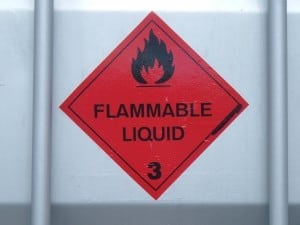Use DOT approved gas cans for safe fuel transport and storage
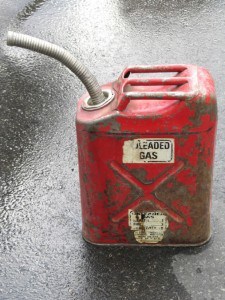
When it comes to safe storage and transport, not all gasoline cans are equal
Companies of all shapes and sizes frequently store — and use — petroleum-based gasoline. Whether it’s to power a portable generator or keep lawnmowers, forklifts, and other heavy machines running. Fuel is a core component in dozens of different industries.
Unfortunately, far too many companies store or transport their fuel in the wrong containers. This means they leave themselves vulnerable to fines and legal action while creating an unsafe work environment.
So, how should you store fuel and combustible liquids in the workplace? Is the common red plastic gas can suitable for use on your job site? Read on to learn more.
OSHA requirements for fuel containers
The Occupational Safety and Health Administration’s (OSHA) Standard 1926.152(a)(1) states the following:
Only approved containers and portable tanks shall be used for storage and handling of flammable liquids. Approved safety cans or Department of Transportation approved containers shall be used for the handling and use of flammable liquids in quantities of 5 gallons or less, except that this shall not apply to those flammable liquid materials which are highly viscid (extremely hard to pour), which may be used and handled in original shipping containers. For quantities of one gallon or less, the original container may be used, for storage, use and handling of flammable liquids.”
What is a DOT approved gas can?
Under OSHA Standards, workplaces must store all gasoline in quantities of 5 gallons or less in a DOT-approved container. Which is a fuel can with safety features that help reduce the risk of a fire. So, basically, a gasoline storage container that has a:
- flash-arresting screen;
- spring-closing lid; and
- spout cover.
These design elements not only protect vapors from ignition sources. They also relieve internal pressure in the event the container is subject to fire exposure.
In addition, for safer transportation, the closed container needs:
- a filling cap with hold-down locking brackets to stop accidental spillage during transport
- rugged handle drop protection like a roll bar to prevent damage to the spout and trigger mechanisms.
DOT approval is only given by a nationally recognized testing laboratory, like Underwriters’ Laboratory, Inc. These requirements ensure greater safety when transporting gasoline cans on roads and highways. In other words, there’s less risk of fire or explosion if traveling with fuel cans in the back of your pickup truck.
One other thing to note is that cans come in different colors depending on their contents. Use red cans for gasoline and yellow cans for diesel fuel.
How is DOT-approved different from other safety cans?
In summary, OSHA requires commercial businesses to use FM-Approved and/or UL Listed safety cans. These containers may be of metal or polyethylene construction. However, they must have flame arresters, self-closing lids, pressure relief, and 100% leak testing features.
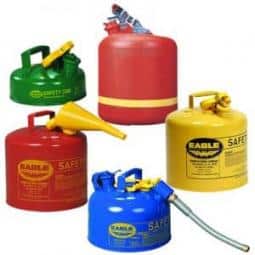
Type 1 and 2 fuel cans come in different colors, materials, and sizes to safely store and dispense contents
Safety cans can come in a range of materials, colors, sizes, and capacities. There are even two different kinds to choose from:
- Type I Safety Cans have only one opening. That is, you pour and fill from the same spout.
- Type II Safety Cans have two openings — one to pour and one to fill (the fill opening serves as a vent when pouring).
As well, color coding the containers helps easily identify the fluid contents inside. Red is for gasoline; yellow for diesel; green for combustibles; and blue for kerosene.
All of them can hold gasoline and other flammable fluids. So, how do you know which is the correct vessel to use? Well, regulatory container compliance depends on two things:
- Who is using the fuel and in what location: for example, whether a person is at home or work.
- The fuel’s application: for instance, storing and transferring liquid flammables versus transporting them.
But, when it comes to workers transporting fuel to and from job sites, a specific type of container is necessary. That’s because moving vehicles subject fuel cans to a higher potential of damage, spills, and accidents. In this scenario, you must use a DOT-approved gas safety can.
EPA approval is not the same as DOT approval
Just because a gas can has the Environmental Protection Agency (EPA) approval doesn’t mean it is also Department of Transportation (DOT) approved.
Similarly, there are several other label standards you may come across. For example, NFPA (National Fire Protection Association) or CARB (California Air Resource Board) compliant. Again, these are completely separate regulatory certifications from DOT.
DOT’s strict regulations raise the bar for fuel can manufacturers such as Eagle and JustRite. The Department of Transportation considers flammable and combustible liquids to be hazardous materials. This is why it requires approved safety cans for use in any commercial vehicle transporting fuels on public roads and highways.
Tips for handling and storing gasoline at work
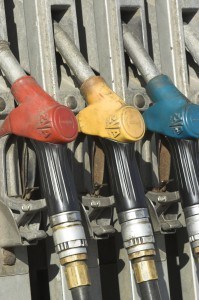
Keep your workplace and workers safe when using fuel
If your business stores, dispenses, and transports fuel — or, any hazardous liquids and solvents, for that matter — here are some general safety tips to consider:
- Store gasoline in a fire-proof storage cabinet when possible (even smaller amounts).
- Only use approved containers with a tight-fit locking cap or spring closing lid.
- Keep fuel away from fire, heat sources, and spark-generating machines.
- If you spill gasoline, clean it up immediately.
- Stage fire extinguishers nearby to containers in case of a fire.
- Always secure safety cans during vehicle transportation.
- Do not fill containers inside vehicles, including trunks, pickup truck beds, or on any surface other than the ground.
- Have containers at a safe distance away from vehicles, other customers, and traffic.
- Keep the nozzle in contact with the can during filling.
- Do not overfill fuel cans — allow at least 5% space to allow for expansion, especially in hot weather.
- Shut off your equipment motor and allow time for it to cool off before refueling.
What about onsite gasoline or diesel fuel storage?
According to CFR 1926.152(b)(2)(i), gasoline in excess of 25 gallons or more must be stored in a special fire-proof cabinet. These gasoline storage cabinets can have either metal or wood construction.
If the fuel storage cabinet is made of wood, however, it must meet the following criteria: “The bottom, sides, and top shall be constructed of an exterior grade of plywood at least 1 inch in thickness, which shall not break down or delaminate under standard fire test conditions. All joints shall be rabbeted and shall be fastened in two directions with flathead wood screws.”
Order your fuel containers and storage cabinets from the experts
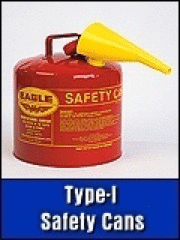 Protect your workers. Protect your workplace. Protect yourself. Make sure your storage containers are safe and comply with OSHA requirements.
Protect your workers. Protect your workplace. Protect yourself. Make sure your storage containers are safe and comply with OSHA requirements.
When you’re purchasing gas containers for your workplace, check to make sure they have the DOT-approved seal. Reserve those cheap, red plastic gas cans for home use only!
Let us know if you need help selecting the right container or storage solution. We offer a broad selection of compliant cans and cabinets with competitive pricing.
This is a revision to a blog post with an original publication date of May 1, 2014
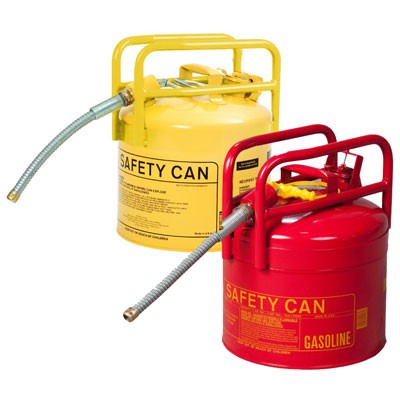
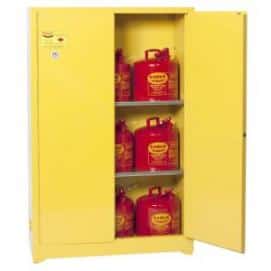
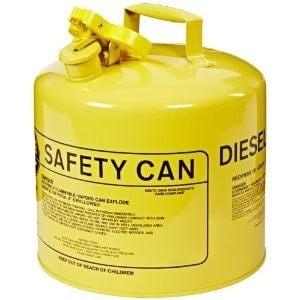 An approved safety can is needed when you store flammable or combustible liquids — such as gasoline, kerosene, diesel, propane, isopropyl alcohol, and various oils — at your worksite. You can’t just use any container.
An approved safety can is needed when you store flammable or combustible liquids — such as gasoline, kerosene, diesel, propane, isopropyl alcohol, and various oils — at your worksite. You can’t just use any container. 
